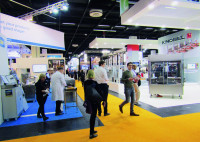In order to avoid capacity bottlenecks in central data processing, confectionery manu- facturer August Storck KG decided on an IT solution from data management specialist NetApp. This solution is economical, available and failsafe. Storage efficiency has been increased and access times reduced.
Data for the production of the confectionery of August Storck (see box) is processed centrally in Halle/Westphalia. Since 2010, this site has been using classic MetroCluster systems, consisting of SAS disks, as the primary storage – now in their third generation. In addition to virtual Windows servers, user data, mainly in the form of Office documents and PDFs, requires storage space.
Storage space requirements constantly increase as new IT systems and applications are added. At the same time, access times need to be kept as short as possible. Before capacity could threaten to reach breaking point on account of the growing data volume, Storck in 2016 decided to ensure that its virtualized VMware IT landscape was fit for the future and able to replace the controller heads and the related disk shelves.
Due to the extensive system requirements in terms of availability and reliability, Storck turned to its long-term partners NetApp and Computacenter. IT service provider Computacenter has been providing Storck’s IT department with advice and support for its IT projects for several years. Data management specialist NetApp is the only manufacturer which supplies the confectionery and chocolate specialist with storage.
All-flash system can be expanded specifically
“With regard to storage, August Storck KG entered into a strategic partnership with NetApp which has worked exceptionally well over the years”, says Malte Rudolf, Server Infrastructure Team Lead at Storck. In connection with this, he makes reference to NetApp’s MetroCluster systems, which were jointly set up in Halle, Ohrdruf and Berlin, before going on to mention two NetApp high-availability systems. In Halle, Storck operates SAP Hana on these systems in order, for example, to use the Business Warehouse (BW) for analyzing large amounts of data in real time. In addition, an FAS6250 MetroCluster is used for the remaining SAP systems and as a central archiving system.
At the beginning of 2017, an AFF A700 all-flash system was installed in Halle for the MetroCluster. All-flash is the best solution for fulfilling the requirements of Storck in terms of storage protocols, speeds and volumes. Furthermore, the capacity of the selected system can be expanded specifically, providing sufficient room for maneuver in the future. “With flash, I’m buying performance and availability for the next few years”, Malte Rudolf confidently states. “In terms of primary storage, the development trend is clearly heading in the direction of all-flash. Of course, we can’t let the train fly past us on this one. We have to jump on board”, he stresses, acknowledging: “Performance levels are off the scale.”
The integration partner Computacenter took care of the hardware set-up and storage configuration of the all-flash system. The IT service provider also helped Malte Rudolf’s IT team by providing support when they migrated the data to the Ontap9 data management system largely by themselves. Once the data had been successfully migrated, the previous FAS3250 MetroCluster was dismantled. The in-house IT team now has storage, availability, capacity, performance and data backup in full view thanks to the OnCommand Unified Manager, a tool that warns you as soon as there are any irregularities in the Ontap environment.
Database queries are executed much faster
In view of such conditions, the AFF A700 could be put into operation extremely fast. There were no real challenges to overcome in the implementation and migration processes as both went smoothly. “This speaks volumes for NetApp systems”, Malte Rudolf commented. The technology upgrade to all-flash FAS in the data center in Halle consolidated the storage landscape and resulted in the
desired performance improvement. The new installation now also enables Storck to benefit from inline deduplication, a function which has been provided by NetApp’s all-flash FAS arrays for some time now.
Inline deduplication is carried out upon access. “Put simply, the feature searches for data blocks sent in duplicate which it then stores just once. If, for example, two employees want to store the same image, only one writing operation will be conducted on flash. In an infrastructure such as ours, these types of duplicate data blocks are very common”, explains a thrilled Malte Rudolf. The resulting storage efficiency is noticeable. “This technology saves us up to 40 percent of storage capacity”, calculates the Team Lead. He is also impressed with compression and compaction. These are two more in line features which all-flash inherently offers and which save users space on their systems.
What’s more, the new flash generation also considerably shortens latency. Prior to implementation, the IT department carried out some speed measurements in order to test actual performance. “We were really thrilled to see how quick the systems are”, says the IT expert, depicting the impression which the tests left on his IT team.
Users only notice the difference in speed in their normal applications to a limited extent, if even at all. However, database queries, for example, are now executed much more quickly. “In the majority of cases, accessing the storage media takes less than one millisecond. And there are loads of IOPS above 100,000 with latency of less than one millisecond”, reports Malte Rudolf. “Only all-flash FAS arrays can achieve that.” As such, the installed all-flash solution provides optimum conditions for migrating the remaining SAP systems and SQL databases, which are currently still running on the 6250, to the AFF A700.
The user
August Storck KG has been making high-quality confectionery and delicious chocolates for decades. The company, which started out in 1903 as a confectionery factory, is still a family-owned business to this day and is now one of the world’s ten largest confectionery manufacturers. It sells its products, which include brands such as Toffifee, Merci, Werther’s Original, Knoppers, and nimm2, in 100 countries spread all around the world. More than 5,800 employees work at the German production sites in Berlin-Reinicken-dorf, Halle/Westphalia and Ohrdruf, as well as at international subsidiaries.



























































